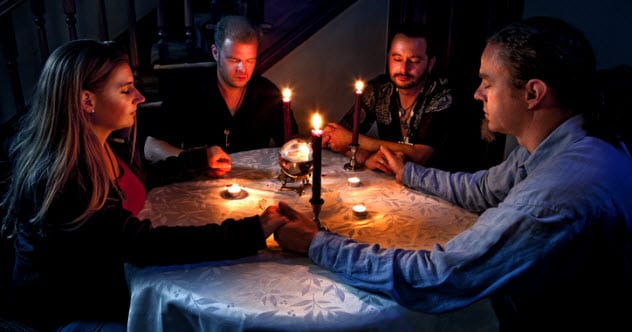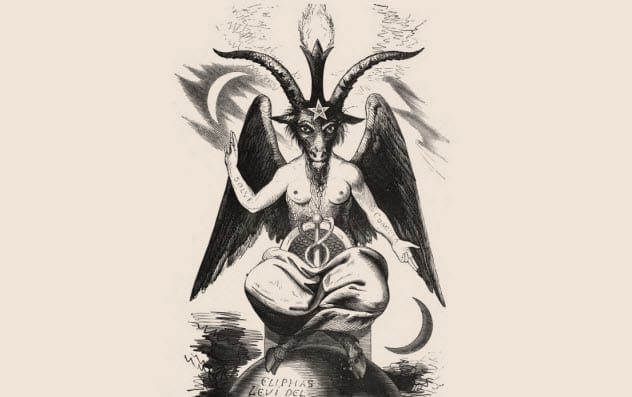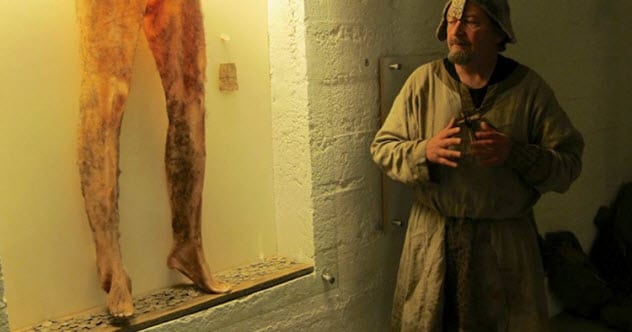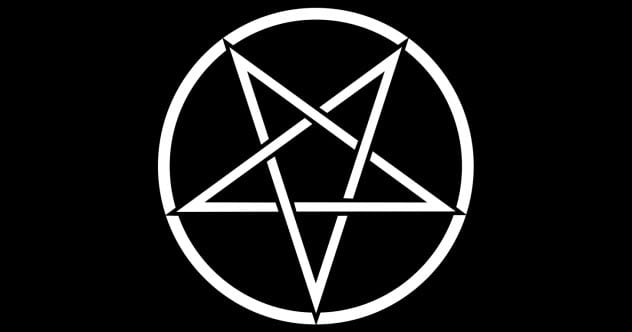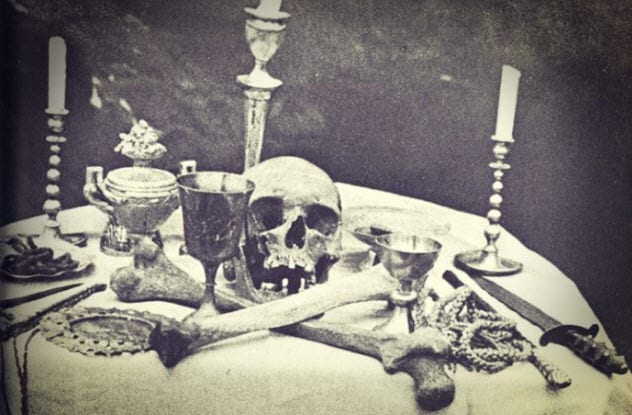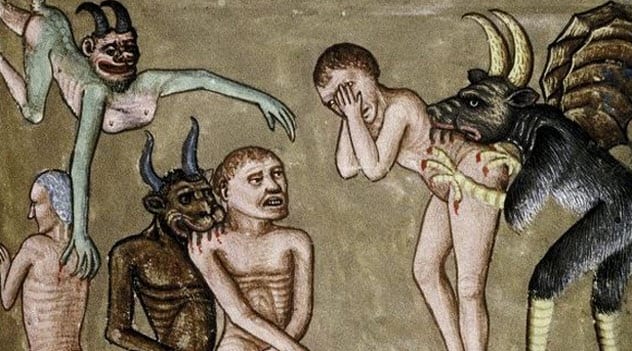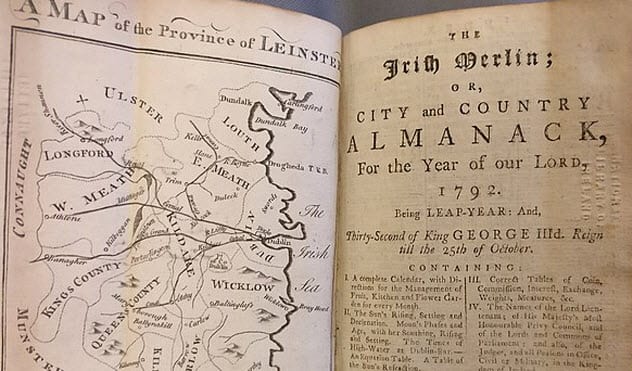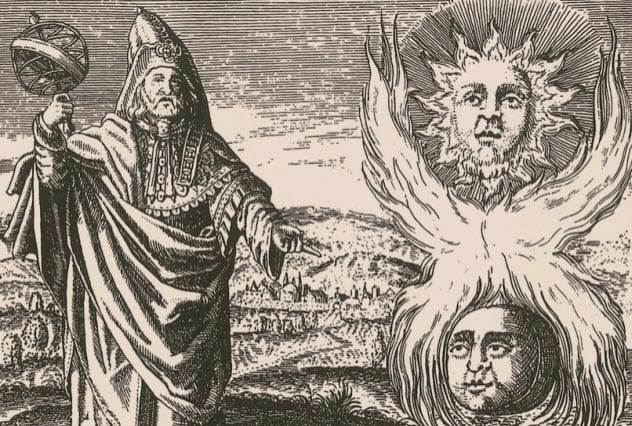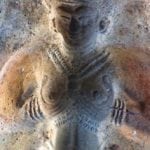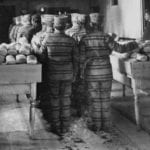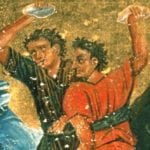For all the fear that Christianity has bestowed upon occultism, the practice itself isn’t exactly harmful. In fact, it often serves as a spiritual experience for its practitioners, much like the belief in unorthodox deities such as Satan. Here are 10 strange and unusual occult practices from history.
10 Seances
Seances are occult practices conducted by mediums, almost always intending to contact the dead or persons who’ve crossed over to another plane. The French word “seance” translates to “sitting” in English, where practitioners would “sit” with spirits from another world. Usually, practitioners sit in a circle of six to eight people, hold hands, and attempt to diminish any distractions which may hinder their desired result of summoning the dead. Sometimes, mediums report hearing otherworldly voices along with seeing ghosts manifest from another world. At times, it is believed that the ghost speaks through the medium. Reportedly, ghosts have also used instruments to write, such as the famed Ouija board or pens or pencils that inscribe some communication on an object. As the focal point of the seance, the medium is believed to make otherworldly contact with the dead. Some reports claim that a medium levitated in the air during a seance. However, it’s doubtful that modern science has developed any concrete evidence of such an event actually happening.[1] So what is it? Does a seance manifest real supernatural powers? Or is it just another case of people believing what they want at the expense of their reason?
9 Symbology
In the occult, symbolism carries a lot of meaning, whether to connect us to hidden worlds or to awaken things that are unconscious. The pentagram, one of the more popular symbols in our culture today, has a rich history that dates back to ancient Babylon. The star represented the pattern that Venus seemingly made in the sky as well as various beliefs. It has evolved to mean different things to different people. Sigils are basically signatures of various deities, other angels, or demons. They are inscribed to manifest certain properties of those entities. This is one way that practitioners reach out to these powers for guidance or strength that they normally would not possess. And then there is Baphomet, one of the best-known occult symbols, which dates to heresy and witchcraft trials of medieval times. It started with The Order in 1118 and served as a protective symbol for Christians when traveling in the Middle East. Baphomet is the well-known goat with the pentagram on his head. Once The Order and the various Christian groups which subscribed to Baphomet became large enough to be considered a political threat to the Church, the symbol changed hands and was banned from the Church through a series of political maneuvers.[2] In time, this became a symbol of torture at the hands of the Church, which was administered to heretics.
8 Necropants
Necropants are an extremely odd bit of occultism stemming from Iceland. They consist of the skin of the legs and feet of the dead and are worn by the living. In fact, the Icelandic people of the 17th century were infatuated with rituals using the bodies of the dead, taking ribs here, skin from sheep there, and mixing it all together into these nightmarish, hodgepodge creatures that are left over to mortify us today. When it came to necropants, a sorcerer had to get permission to use that person’s skin as pants for it to be the right thing to do. This would apparently bring the wearer greatness, good fortune, and even wealth, supposing they could stomach the macabre ritual.[3] At first, necropants were believed to be things of myth. But many of them have turned up and now reside in museums.
7 Divination
Divination is the attempt to gain foresight and knowledge about the future through various methods—from fortune-tellers to Magic 8 Balls to chance readings of a tea leaf or your palm. Psychics and tarot cards also fall under this category. Sometimes, practitioners turn to crystal gazing. Other times, they stare into candlelight or even pools of water. These latter practices involve using the practitioner’s guidance and intuition to let the necessary messages come through and gain some sense of spiritual understanding about future events. These practices have a long, dark history of bloodshed and oppression at the hands of the Church, which still sees divination as an evil incarnation of Satan. However, the occultist doesn’t see it that way. Dating to St. Augustine of Hippo in the fifth century AD, who stated that any pagan traditions and religious practices were of the Devil, the Christian Church became increasingly brutal in its punishments of these practices. By the 13th century AD, any divination or attempt to understand future events was considered demon worship.[4] Between 1450 and 1600, the active period of punishing divination and similar practices, the Christian Church was responsible for the death, torture, and mutilation of tens of thousands of supposed “witches.”
6 Satanism
Although Satanism and the occult aren’t the same thing, both practices have borrowed heavily from one another throughout the centuries. The origins of true Satanism are quite mysterious as the Church has destroyed these cults rapidly wherever they popped up. But Satanic cults have been officially documented in Europe and North America as far back as the 17th century. Satanism finds at least some of its roots in dark figures who were also synonymous with the occult throughout the centuries. Examples would be Hades, the ancient Greek god of the underworld, and Marduk. Thousands of years of worship of these figures have linked Satanism to occult practices because these figures are technically pagan gods and not Satan himself. By the 20th century, Satanism was in full swing. The Satanic Church was established in America in the 1960s. Small cults have also sprung up worldwide. While the members of these groups don’t number in the millions like those of other religions, the strange and sometimes violent practices—like murder or suicide—by Satanic cults make it a well-known movement. Despite their differences, Satanism and the occult are one and the same in the eyes of the Christian Church.[5]
5 Human Sacrifice
Human sacrifice has occurred in some occult practices even to this day. In 1995, a 15-year-old girl named Elyse Pahler was lured to a eucalyptus grove and murdered. Her body was discovered eight months later. The suspects were 17-year-old Royce Casey, 14-year-old Joseph Fiorella, and 16-year-old Jacob Delashmutt. This murder had all the hallmarks of an occultist or even a Satanic rape and killing. The teens returned to have sex with Pahler’s dead body over the ensuing weeks. When Casey confessed, he said that the rape and murder were sacrificial and for Satan. To the authorities, this was definitely an occult human sacrifice, not too unlike ancient times.[6] Many such instances have popped up worldwide. There was a media frenzy about these types of murders in the 1990s in the United States. A notable one was the Vampire Cult, led by Rod Ferrell, and its ritualistic and sacrificial killing of a Florida family. Ferrell was only 16 years old at the time of the murders. The teens in this cult took drugs, performed blood and sex rituals, and eventually traveled from Kentucky to Florida to kill Naomi Ruth Queen and Richard Wendorf. Though rare, human sacrifice has definitely found its way into today’s society, often as an exercise in occultism.
4 Magick
Magick (alternate spelling to distinguish “magic” from “sleight-of-hand” or “stage” magic) in occultism entails efforts to call on extra-sensory forces to know and rule the “spirit” world and even control humans and inanimate objects. The term itself is an Early Modern English spelling for magic, used in works such as the 1651 translation of Heinrich Cornelius Agrippa’s De Occulta Philosophia, Three Books of Occult Philosophy, or Of Magick. Aleister Crowley defines magick as the “Science of understanding oneself and one’s conditions. It is the Art of applying that understanding in action.”[7] Magick ceremonies and those who practice them are seen as channels through which supernatural power affects change in human events and conditions. Those who practice “white magick” seek to produce positive or favorable outcomes. “Black magick” practitioners intend harm and evil results. Aspects of ritual in magick include banishing, invocation, evocation, purification, consecration, and divination (already discussed in this list). Magick is as old as humanity and had its beginnings in humankind’s attempts to control one’s environment, survival, and destiny, either by controlling natural forces or appealing to higher powers for help. Anthropologist Bronislaw Malinowski defined magic as having three functions and three elements. The three functions are to produce, to protect, or to destroy. The three elements are spells and incantations, rites or procedures, and altered states of consciousness accomplished through fasting, meditating, chanting, visualizing symbols, sleep deprivation, dancing, staring into flames, inhaling fumes, taking drugs, and so forth. Magick is practiced universally by skilled individuals who are either born into their powers or train themselves to acquire their abilities.
3 Demonism
With demonism, a practitioner seeks to summon the power of actual demons to bend to their will. According to Christianity and some occultist practices, demons are fallen angels sworn to subvert all good things and to carry out only evil in the world. The Christian religion dating back to the times of the Holy Bible and the first teachings of the early Christians speaks of these dark figures, and they have been a consistent theme in much of recorded history. Some dark figures, like Santa Muerte, Our Lady of Holy Death, an actual death saint, even appear outside of the Christian doctrine, dating back tens of thousands of years. John Milton’s Paradise Lost, which was published in 1667, describes these fallen demons cast out of Heaven in the Christian doctrine.[8] After having been thrown into the dark, fiery abyss, Satan speaks to the demons thus: Fall’n Cherube, to be weak is miserable Doing or Suffering: but of this be sure, To do ought good never will be our task, But ever to do ill our sole delight, As being the contrary to his high will Whom we resist. If then his Providence Out of our evil seek to bring forth good, Our labour must be to pervert that end, And out of good still to find means of evil. Since ancient times, occultists have believed that they can harness these dark spirits to do evil. The practitioners have used ritualistic incantations to summon different demons for various purposes in many cultures throughout history—starting from Satan, the leader of all demons, to Ukobach, the demon in Hell, which attends to the flames. Ihrinwe (aka “The Lord of Blood”) is believed to be responsible for humanity’s most violent acts. Serial killers and brutal dictators have been thought to be under the control of this demonic influence, perhaps even causing most of humanity’s atrocities.
2 Old Moore’s Almanac
Dating all the way back to 1697 in Ireland, Old Moore’s Almanac is a fun little occult publication with apparent prophecies of the future. It’s one of the oldest continual publications which contain horoscopes and other such means for people to supposedly dictate their futures. What was once an anonymous publication is now a magazine complete with an interactive website and plenty for anyone who wishes to see what occult wisdom has in store for them. It also gave weather forecasts. In time, it spawned numerous replicas and fakes. By 1851, an Irish man named John Francis Nugent created a spin-off called Nugent’s Old Moore’s Almanac. He didn’t hide the fact that it was plainly a rip-off, even though the original publication had already been around for over a century. Both almanacs were competitors until Nugent died in 1866. The editor for Old Moore’s Almanac also signed up to be the editor for Nugent’s Old Moore’s Almanac and worked for both publications for years.[9]
1 Hermeticism
Hermeticism is the ancient practice of esoteric wisdom overall and contains a lot of texts and ideas under its umbrella. It is one of the oldest occult practices of all time, beginning with the intermingling of the Greco-Roman and Egyptian cultures and philosophy meeting mysticism. While “popular” Hermeticism is the practice of more common things like astrology, “learned” Hermeticism is a bit deeper and more in tune with the modern concept of Gnosticism. The main goal was to gain a true understanding of God’s knowledge and make the natural out of the supernatural through understanding. In a very real way, this fundamental concept was the obscure, humble beginnings of our scientific advancements today by taming the unknown and making it known. Alchemists, Freemasons, and Gnostics all fall under the branch of Hermeticism. Scholars have suggested that alchemy was never about creating gold but about the lessons learned along the way. Mixing metals to forge gold was never intended to be a realistic possibility. Instead, it was symbolic of the pursuit of knowledge and the futility of attaining material things like gold and wealth. Considering that Hermeticism comes from Pythagoreanism, which is based on mystical teachings of natural harmony, this is a good possibility. Pythagoras was obsessed with finding the secret fundamental substance of the cosmos, which is in line with the goals of all occultism. Alchemy grew out of this tradition. However, Hermeticism differs from science in its aims. Where science seeks to study the natural world, Hermetics seeks to study the supernatural realm in hopes of gaining an understanding from that which isn’t readily apparent or intuitive. Ancient religions aside, Hermeticism is the all-encompassing concept of the search for a deeper, more fundamental knowledge that is the foundation of all occultism.[10] I like to write about dark stuff, history, and philosophy. Here’s a fun little bit telling the history of some of the more dark and esoteric occult practices.
